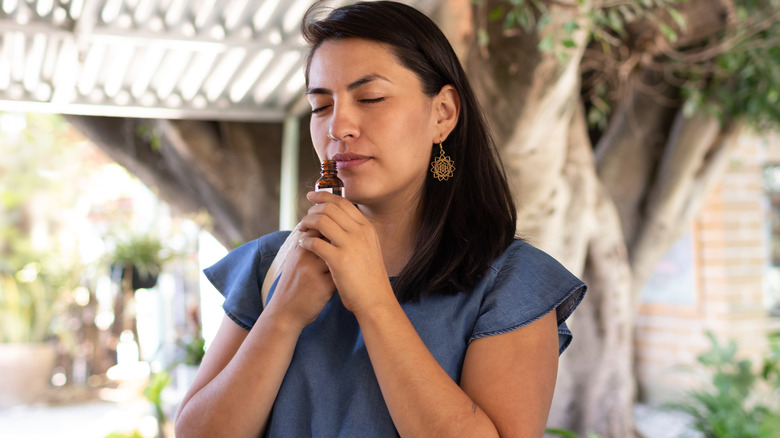Guaiac Wood: What To Know About The Trendy Perfume Note
If you're a perfume or cologne guru, you might have already heard of guaiac wood — the pervasive note that is popping up in bottled scents all over the fragrance scene. But if you're unfamiliar with it, there's no better time than now to familiarize yourself with this raw material.
Although some believe that this earthy, musk-scented perfume ingredient is palo santo in disguise, it's actually a separate, distinct type of wood, per DoTERRA. Those who harvest it locally sometimes refer to guaiac wood as "palo santo," but the palo santo you likely know (Palo Santo Bursera) is different from this species (Guaiacwood Bulnesia sarmientoi). Their oils are also similar, but scent aficionados can typically tell the difference by their aromas alone.
Speaking to Bustle, cosmetic brand Aesop describes guaiac wood as "smokey" with sweetened "powdery notes." As of late, the perfume ingredient has grown in popularity, with more manufacturers including it in their formulations for consumers seeking a new signature scent. Many people are also turning to perfume and cologne with guaiac wood because it's known for its warm, woodsy scent, which remains long after the top notes dissipate. If you're interested in trying it out, however, it might be worth familiarizing yourself with the background of guaiac wood — especially if you're conscious of purchasing sustainable, ethical products.
How sustainable are guaiac wood perfumes and colognes?
In order for a tree to be ethically and sustainably harvested for its oil or extract, the harvester must only retrieve it from felled wood, branches, fruits, or leaves, per Essence of Thyme. Depending on the situation, permits may be necessary in order for certain trees to be harvested, and the planting of new trees might also be required to maintain the population. Over the past 15 years, Essence of Thyme notes that guaiac wood has been considered "vulnerable" and "critically endangered," but it became a species of "least concern" in 2019. Of course, this doesn't necessarily mean you shouldn't shed your concern for the environment if you're shopping for a fragrance that includes guaiac wood.
Unfortunately, there is no legal definition that can tip you off as to whether a fragrance is truly sustainable while you're in the perfume aisle. However, understanding what makes these products unsustainable can give you an idea of what to look out for while browsing. The word "synthetic" might make you cringe in terms of perfume, but these types of fragrances might be exactly what you want if you're thinking in terms of sustainability — sourcing local ingredients (including wood) can be detrimental to the environment. Artificial or "synthetic" ingredients that don't require retrieving something from Mother Nature are far less impactful. When in doubt, lean toward brands that are willing to list the ingredients in their formulas.
The highlights of guaiac wood notes
The scent of guaiac wood has been described in many different ways, but relating it to the aroma of palo santo is most common. If you're unfamiliar with this scent, some of the words used by fragrance company Osmanthōs to paint a picture of guaiac wood include "smokey," "honeyed-sweet," and "earthy." Because of this, it's not unusual to see it in formulations that include tobacco or leather notes as well. Many fans of guaiac wood find that it meshes well with spice notes, as well as vanilla, amber, and cedar scents.
Guaiac wood has been used throughout the ages for a number of purposes — not just in perfume, according to the fragrance blog Scentertainer. Some cultures incorporated it into their furniture, while others simply used it as firewood. Its resin has been used as medicine by some, who recognized its diuretic and laxative properties. Today, it's widely used in perfume scents and colognes, as it is still being produced in large quantities. This means that it can be obtained at an affordable price by manufacturers and used in items, such as fragrances.
If you're new to guaiac wood and you want to try it sustainably, don't forget to do your research beforehand. Having a specific brand or fragrance in mind can make it easier for you to determine how sustainable a product really is before you decide to buy it.


